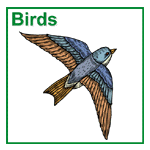| |
Bird walks are popular outings among people of all ages. The best time to look for birds is from dawn to mid-morning, since most avian species are active during that time. Regardless of other equipment you choose to bring, binoculars and a field guide are essential. Regularly scheduled bird walks on our site have the following benefits:
- improve identification skills of your wildlife team,
- stimulate interest in wildlife and wildlife programs among employees and in the community, and
- increase your inventory of birds.
When identifying birds, it is often helpful to determine the general type of bird it is. and then use your guide to narrow down the species. Familiarize yourself with the set-up of your field guide. This will allow you to quickly refer to the appropriate section when you see a bird. For example, most field guides have sections on waterfowl, birds of prey, woodpeckers, etc.
Descriptive elements that are heIpful in identification are:
- coloration and patterns on tail, eyes, back, and wings;
- bird size (can be relative, e.g. smaller than a pigeon, bigger than a wren);
- body, wing, tail. and bill shapes;
- behavior (perching. darting, wagging tail, climbing, etc.);
- flight pattern (soaring, dipping, etc.): and
- song.
Info-Links
|
 |

